Ijraset Journal For Research in Applied Science and Engineering Technology
- Home / Ijraset
- On This Page
- Abstract
- Introduction
- Conclusion
- References
- Copyright
Providing an Attempt to Reduce Evaporation Losses of Dam, By Providing Solar Panels: A Case Study of Jayakwadi Project
Authors: Aniket A Dhadve, Buddhabushan R Gaikwad, Vaibhav E Damse, Prashant T Hake, Dr. N. V. Khadake
DOI Link: https://doi.org/10.22214/ijraset.2022.42065
Certificate: View Certificate
Abstract
Recently, the technology of floating photovoltaic panels has demonstrated several advantages over land installations, including faster deployment, less maintenance cost, and higher efficiency. Jayakwadi Dam is the second largest Earthen Dam in India with a surface area of 350 square km. Evaporation of water causes loss of very precious and scarce resources: freshwater. Fortunately, the lake is also located in a very rich area in solar energy. This paper presents a study to utilize Jayakwadi Dam surface for massive production of solar energy, while significantly reducing the loss of water by evaporation from the lake surface. The project has the potential to be one of the largest producers of low-cost clean electric energy in India. The study shows that the first phase of the project is expected to deliver about 86.12 MW/Day of electricity and save about 5.5 TMC per year of freshwater. The subsequent phases will provide low- cost green energy to replace the combustible fuels in Europe by 2045, while saving up to 10-12 billion m3 of freshwater lost by evaporation from Jayakwadi Dam
Introduction
I. INTRODUCTION
Photovoltaic solar panels absorb sunlight as a source of energy to generate electricity. A photovoltaic module is a packaged, connect assembly of typically 5x4 photovoltaic solar cells. Photovoltaic modules constitute the photovoltaic array of a photovoltaic system that generates and supplies solar electricity in commercial and residential applications.
Each module is rated by its DC output power under standard test conditions, and typically ranges from 100 to 365 Watts
A single solar module can produce only a limited amount of power; most installations contain multiple modules. A photovoltaic system typically includes an array of photovoltaic modules, an inverter, a battery pack for storage, interconnection wiring, and optionally a solar tracking mechanism.
The price of solar power has continued to fall so that in many countries it is cheaper than ordinary fossil fuel electricity from the grid.
The area wise survey of the surface area of water is done and from this data the number of the floating solar panel is calculated.
Some open space is left vacant for the purpose of fisheries and outlet of water near the spillway and the wall of dam. As the panels are floating so they acquire less area and they change their direction as per wind directions and other factors.
As the water from the dam gets evaporated continuously, the rate of evaporation can be reduced by using floating solar panels. So, the amount of water that can be used by the people is increased. The shortage of electricity due to scarcity of non-renewable sources like coal for thermal power plant gets reduced.
II. OBJECTIVES
- The main aim of project is to control the evaporation of water and to generate electricity by using floating solar panel.
- The electricity generated by this solar panels can be used by the people for their day-to-day household activities and commercial activities.
- Thus, the burden on the traditional sources of electricity such as hydropower plants and thermal plants gets reduced to some extent
- The formation of algae and vegetation gets reduced.
- The probable problems of Land Accusation do not occur.
- Problems of over heating does not occur due to in continuous contact with water surface.
III. METHDOLOGY
- Solar Panels
The power generating capacity is major concern while selecting the panels. The panels are classified as poly, mono, thin film or hybrid panels. The panel efficiency gives the space occupied by solar panel for amount of power generation. Most crystalline modules will perform in a very similar, and will take up roughly the same space. Hybrid panels will generate a larger power from a smaller area. However, they are too expensive compared to crystalline panels thin film modules are very well suited to dull, diffuse conditions. They take up a lot more area than other types, but durability is very less. The cost of solar panels also depends on location of manufacturing and transportation charges.
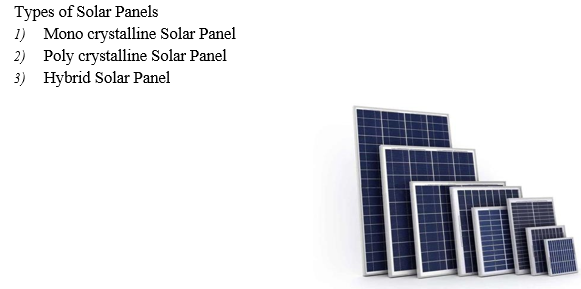
a. Mono Crystalline Panels: The solar cells in monocrystalline panels are slices cut from pure drawn crystalline silicon bars. The entire cell is aligned in one direction, which means that when the sun is shining brightly on them at the correct angle, they are extremely efficient. So, these panels work when the sun is shining directly on them. They have a uniform black color because they are absorbing most of the light. There are unused spaces in the solar module.
b. Polycrystalline Panels: Polycrystalline panels are made up from the silicon off cuts, molded to form blocks and create a cell made up of several bits of pure crystal. The individual crystals are not perfectly aligned together and so there are losses at the joints between them, which make them inefficient. However, this misalignment can help in some circumstances, because the cells work better from light at all angles, even in low light also. The panels are little bluer as they reflect some of the light. Since they are cut into rectangular blocks, there is very little wasted space on the panel. These panels have more uniform appearance with their rectangular shape.
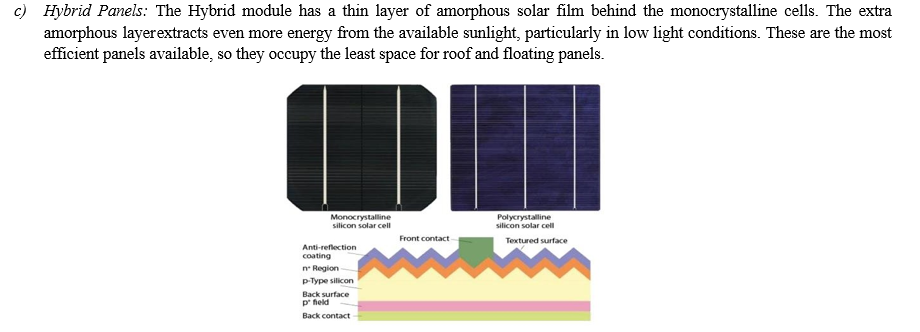
B. Floating Material (HDPE)
Bimodal HDPE possesses highly regular arrangement of un-branched chains along with the copolymer of desired branched structure to maintain the impact strength along with the load bearing characteristic. Normally, these resins are produced using two polymerization reactors in series (LMW and HMW), each operated under separate process conditions. This process allows all of the commoner to be incorporated into the high molecular weight fraction, where it is most needed to influence properties. The result of this technology is a substantial leap in physical properties at a given resin density Types of floating materials
- PS (Polystyrene)
- PP (Polypropylene)
- PE (Polyethylene)
- PA (Polyamide)
- ABS (ABS polymer)
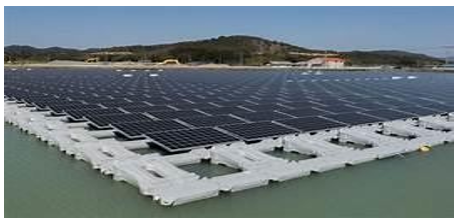
C. A Case Study on Jayakwadi Dam
Introduction It is one of the largest irrigation projects in the Indian state of Maharashtra. It is a multipurpose project. The water is mainly used to irrigate agricultural land in the droughtprone Marathwada region of the state. It also provides water for drinking and industrial usage to nearby towns and villages and to the municipalities and industrial areas of Aurangabad and Jalna district. The intake source of the dam is Godavari River and PravaraRiver.
Dam Jayakwadi is one of the largest earthen dams in Asia. Its height is approx. 41.30 m and length of 9,998 m (10 km approx.) with total storage capacity 2,909 MCM (million cubic meters) and effective live storage capacity is 2,171 MCM. The total catchment area of dam is 21,750 km2. There are total 27 water gates for the dam. In the year 2022 it has entered in 48rd year of its life. It has in its lifetime overflowed only 17 times. On 10 August 2006 highest discharge of 250000 ft3 /s was recorded in India of Maharashtra state district Aurangabad.
This dam is located at Paithan, Maharashtra (India Coordinates 19°29′8.7″N 75°22′12″E) Construction began in 1965 and completed in 1976. Construction cost required was 4,700cr. Owner of the project is Government of Maharashtra. This is an Earthen type of dam. This dam impounds water from Godavari River. Height of dam is 41.30m (135ft), Length of the dam is 9,998m (32,802ft). This project Creates NathSagar Jalashay. The Total capacity of reservoir is 2.909 km3 (1.027×1011cuft). Catchment area is 21,750 km2 (8,398sqmi) and Surface area of the reservoir is 350 km2 (135sqmi). The capacity of Power Station is 12MW
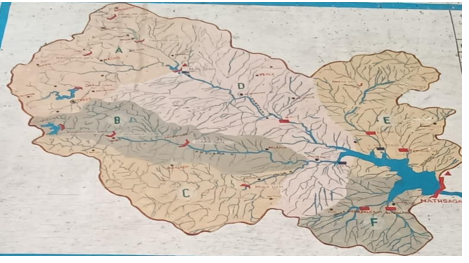
D. Calculations
Standard size of solar panel = 5x4ft. = 20ft.sq.
Assumed area of installation = 210km.sq = 6889763.77 fts. No. of solar panels = 6889763.77/20 = 3,44,488nos.
Cost of one solar panel = 17500/-
Total cost of solar panels = 3,44,488x17,500 = 6,02,85,40,000/- i.e., 600cr approx.
Electricity generation = No. of panels x 250(wattage) = 3,44,488 x 250 = 8,61,22, 000wattage i.e 86.12MW
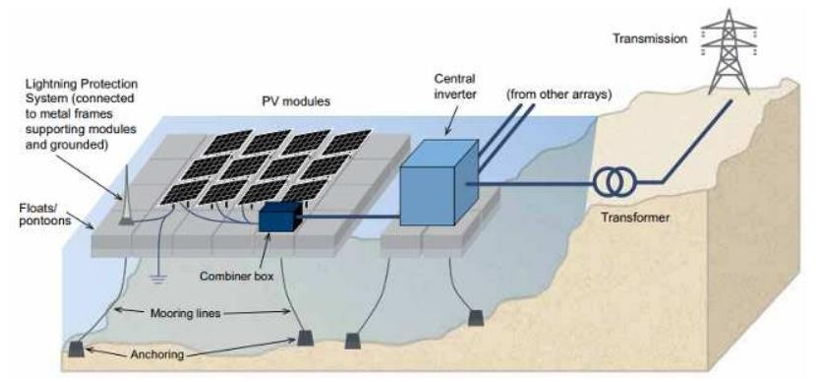
IV. LITERATURE REVIEW
- Paritosh Sharma (2015) studied design parameters of 10kw floating solar power plant
- Panels are naturally cooled as the air just above the water bodies has high content of moisture and hence it automatically solves) the issue of heating losses that occur during its operation.
- Reduce evaporation by up to 70%.
- Cement structures like boilers and chimneys that are used in power plants like thermal have no scope in such a plant. Also, electro- mechanical machines like generators are not required which reduce the amount of steel structures in the plant. Therefore, such plants are comparatively more eco-friendly.
- It can also improve water quality. As water bodies are exposed to the sun, photosynthesis promotes growth of organic matter, including algae. By shading the water, algae growth is reduced, minimizing the associated treatment and labor costs. Moreover, the concept of more generation due to cooling of the panel surface can be experimented in due course as the investment is nearly 1.2 times the conventional land solar plants.
- N. Krishnaveni, P. Anbarasu& D. Vigneshkumar (2016) studied a survey on floating solar power system The characteristics of these structures should be:
- The material used for structure should be completely non-toxic, resistant to salt water and alkalis acids, UV rays resistant and completely recyclable.
- The structures should be able to withstand temperatures from -60°C to 80°C. (c)Long life time that is 30 years withstand capability under water.
With the advancement in solar photovoltaic system, the floating solar power plant plays a vital role. The advantage of the floating system is reduction of evaporation, thus helping preserve water levels during extreme summer. When panels are installed on floating platform, the heating problem of solar panel on land is solved to a great extent. This floating technology is long- lasting, cost effective, flexible and less time for installation. The advantages and technical details of floating solar power plant are presented in this paper. With this advancement, country like India can meet its power demand in future
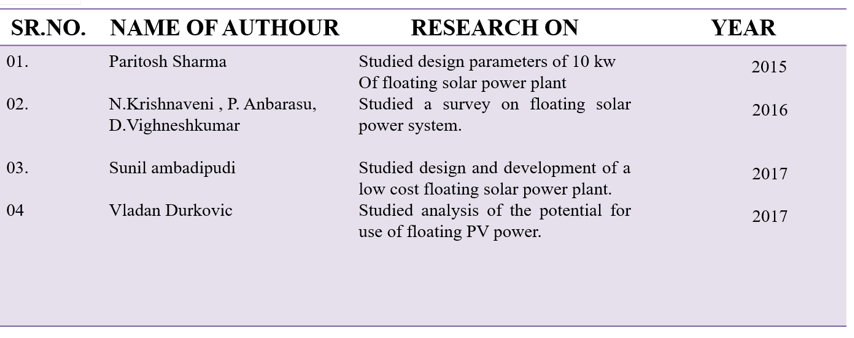
Conclusion
1) Reduce evaporation by up to 70%. 2) From the above mention the research work of different people and are experimental work we conclude that by using floating solar panel on dam water the rate of evaporation can be reduce some extend and also electricity production can be done. 3) Cement structures like boilers and chimneys that are used in power plants like thermal have no scope in such a plant. Also, electro-mechanical machines like generators are not required which reduce the amount of steel structures in the plant. Therefore, such plants are comparatively more eco-friendly. 4) It can also improve water quality. As water bodies are exposed to the sun, photosynthesis promotes growth of organic matter, including algae. By shading the water, algae growth is reduced, minimizing the associated treatment and labor costs Moreover the concept of more generation due to cooling of the panel surface can be experimented in due course as the investment is nearly 1.2 times the conventional land solar plants 5) A cost effective floating solar power generation system of module capacity is designed and developed, using the materials that are readily available in rural areas. This model can be harnessed at optimum level to boost rural economy.
References
[1] DESIGN PARAMETERS OF 10KW FLOATING SOLAR POWER PLANT PARITOSH SHARMA1 , BHARAT MUNI2 , DEBOJYOTI [2] SEN3 4th Year Students, EN Dept, IMS Engineering College, Ghaziabad2 Assistant Professor, EN Dept, IMS Engineering College, Ghaziabad3Name of Publisher:-N. Krishnaveni , P. Anbarasu& D. Vigneshkumar [3] A SURVEY ON FLOATING SOLAR POWER SYSTEM N. Krishnaveni*, P. Anbarasu** & D. Vigneshkumar*** * Assistant Professor, Department of Electrical &Electronics Engineering, Dr. Mahalingam College of Engineering and Technology, Tamilnadu ** Assistant Professor, Department of Electrical & Electronics Engineering, Sri Eshwzar College of Engineering, Tamilnadu *** Deputy Manager (Projects), Global Wind Infrastructure Services Private Limited, Maharashtra [4] DESIGN AND DEVELOPMENT OF A LOW COST FLOATING SOLAR POWER PLANT SUNIL AMBADIPUDI#1, SRINIVASA RAO [5] GAMPALA#2, S.VENKATESWARLU#3 Assistant Professors, Dept of Mechanical Engg, SwarnaBharathiInstitue of Science and Technology, Khammam [6] Analysis of the Potential for Use of Floating PV Power Plant on the Skadar Lake for Electricity Supply of Aluminium Plant in Montenegro VladanDurkovi´c 1,2,* and Željko?uriši´c 2 ID [7] Armstrong, Robert (12 November 2014). \\\"The Case for Solar Energy Parking Lots\\\". Absolute Steel. Retrieved 15 November 2014. [8] \\\"Photovoltaic power generation in the buildings. Building integrated photovoltaic–BIPV\\\" (PDF). Bef-de.org. Retrieved 2011-06-20. [9] Elhodeiby, A.S.; Metwally, H.M.B; Farahat, M.A (March 2011). \\\"Performance Analysis of 3.6 kW Rooftop Grid Connected Photovoltaic System in Egyp\\\" (PDF). International Conference on Energy Systems and Technologies (IC- EST 2011): 151–157. Retrieved 2011-07-21. [10] \\\"Kyocera, partners announce construction of the world\\\'s largest floating solar PV Plant in Hyogo prefecture, Japan\\\". SolarServer.com. 4 September 2014. [11] \\\"Running Out of Precious Land? Floating Solar PV Systems May Be a Solution\\\". EnergyWorld.com. 7 November 2013.. [12] Sustainable Practices (Online) http://farniente.com/napa-wine-estate/sustainability/ [13] Sustainability for GundlachBundschu (Online) http://www.gunbun.com/solar [14] Strutture Per ImpiantiFotovoltaiciGalleggianti (Online) http://www.fotovoltaicogalleggiante.com/photovoltaic_floating_plants.html
Copyright
Copyright © 2022 Aniket A Dhadve, Buddhabushan R Gaikwad, Vaibhav E Damse, Prashant T Hake, Dr. N. V. Khadake. This is an open access article distributed under the Creative Commons Attribution License, which permits unrestricted use, distribution, and reproduction in any medium, provided the original work is properly cited.

Download Paper
Paper Id : IJRASET42065
Publish Date : 2022-04-30
ISSN : 2321-9653
Publisher Name : IJRASET
DOI Link : Click Here
 Submit Paper Online
Submit Paper Online

